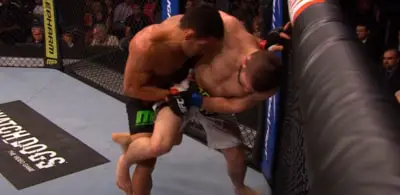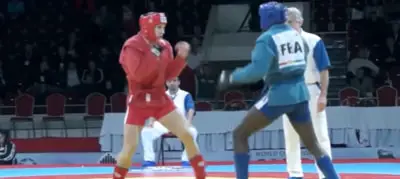
Although Sambo originated from the 1920s, its rules are still pretty unknown to the western combat sports audience. That’s why in this article, I’ll try to explain the rules of sambo and how it’s scored.
There are two main types of sambo – sport sambo and combat sambo.
Sport Sambo has a very similar ruleset to Judo but it’s scored a little differently. You need to score 12 points lead to get the total victory. Throws are scored from 4 to 1 points depending on your position and the position of your opponent. If you fall down with the opponent as you throw him/her, you get fewer points than if you remain standing. If the opponent falls on his back your get more points than if he falls on his side, buttocks or chest.
The position is also important. To get maximum points you need to throw the opponent when he is standing (not having contact with the matt with any part of the body other than the feet).
If you perform a total throw – making your opponent fall on his back or roll rapidly while you remain standing, that’s a total victory.
Pins (or hold-downs) are also scored in sambo. That’s when you hold your opponent down on his back so his shoulder blades are in contact with them matt for a certain period of time. Pins can be scored 4 or 2 points, depending on how long you hold your opponent down.
In Sambo, submissions are also allowed. You can submit your opponent using arm or leg locks to get the total victory. In case no one has a 12 point lead before the 5-minute match is over, the winner is the person with more points.
Combat sambo is a little different. The same rules apply there but strikes are also allowed. You can throw punches, kicks, knees, and elbows and even headbutts. Strikes aren’t scored but you can still win by knocking your opponent out, knocking him down twice or make him submit to strikes. Also, unlike in sport sambo where you can use only arm and leg locks, in combat sambo chokeholds are allowed and almost all submissions that we see in MMA as well.
In the rest of the article, I’ll talk about the scoring in detail (how many points give you the different types of throws); the ways to win, some of the faults in sambo and what equipment is used in competitions.
Sport Sambo
Sambo stands for self-defense without weapons (in Russian) and it was inspired by judo and Japanese jiu-jitsu. It was originally created as a soviet union military martial art. The goal of sambo is to finish the opponent (submit him/her) as quickly as possible and to do that without risking getting hurt.
That’s why in sambo throwing your opponent on his back while you remain standing is scored so high. That’s a very useful tactic in a self-defense situation.
The sambo match duration is 5 minutes.
Ways to win
There are four main ways to win a sambo match:
- Have more points at the end of the match
- Achieve 12 point lead
- Perform a perfect throw
- Submit your opponent – you can do arm and leg locks (other than kneebars, rotation leg locks – heel hooks, toe holds and small joint manipulation – attacking finders and toes). The other prohibited submissions are spine twists, neck cranks and police arm lock (I know this is weird).
You also aren’t allowed to apply any submission in standing position. Another important thing to mention is that you have 60 seconds to apply a submission. If you aren’t able to submit your opponent for 60 seconds from the moment you applied the painful hold (arm or leg lock), the referee resets the action in the middle of the matt.
That way you can’t just hold the opponent’s leg without making him submit and stall the match. In case you go for another submission, the referee starts counting 60 sec again.
And as in every 1 on 1 sport, you can also win if your opponent gets disqualified if he’s injured and can’t continue or of he/she quits.
Point System
The only things scored in combat sambo are throws and pins.
Pins
Pins or hold-downs can be scored 4 or 2 points depending on how long are they. If you manage to keep your opponent in a hold-down for over 20 sec you are awarded 4 points. If the time is 11-19 sec you get 2 points. And if it’s less than 10 sec you don’t get points but you are awarded “Activity” (“A”). That’s important because when both competitors have an equal amount of points by the end of the match, the more active fighter gets the win.
Throws
How much points you get awarded after a throw depends on 3 things:
- The position of the opponent (whether it’s standing or your knees or hands are touching the mat)
- The way he falls (on his back, side, shoulder, knees, etc)
- Your position after the throw (whether you remain standing or you follow the opponent to the mat)
If you manage to throw the opponent on his back from a standing position or make him roll rapidly, while you remain standing, that’s called a total throw and means that the match is over, and you get the win.
Here’s a table with the points you get depending on the factors I mentioned:
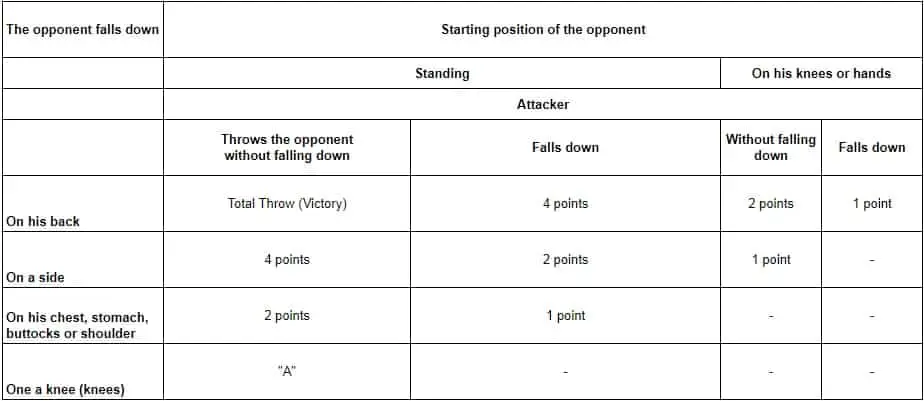
Cautions and Warnings
Doing illegal things during the bout such as applying illegal holds, throws (for example throwing the opponent on his head), rough fighting, throwing blows, talking during the bout and others can get you disqualified.
The same thing with stalling (passivity). For example, things such as unwillingness to engage, intentionally stepping off the mat, or obviously pushing the opponent off the mat, switching to ground position without trying to throw/take your opponent down (also called pulling guard in BJJ) is considered stalling.
If you are doing too much of it, you’ll get disqualified.
Equipment
The equipment in sport sambo is simple:
- Kimono-like Jacket
- Shorts
- Boots
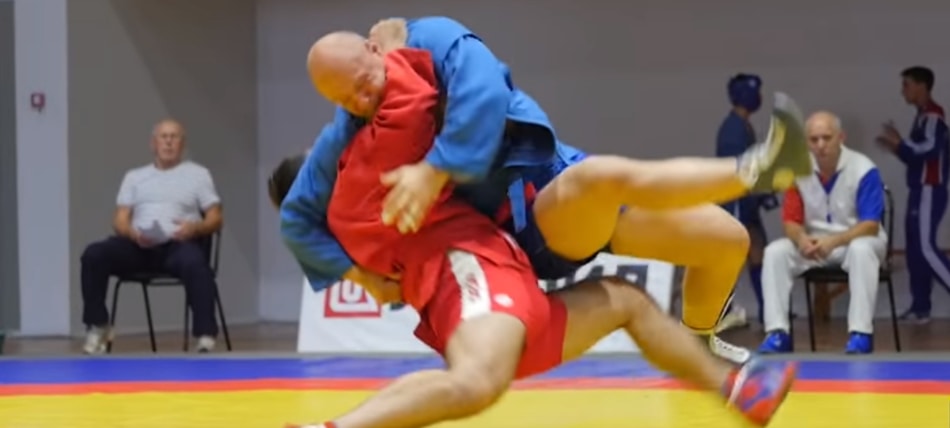
Combat Sambo
Combat Sambo is very similar to MMA. Other than the ruleset, the only differences are the equipment, the mat (there’s no cage in sambo) and the length of the match (5 minutes for combat sambo and 15 or 25 minutes for an MMA bout).
Point System
The point system in combat sambo is almost the same as sport sambo. The only differences are that you can also win by a knockout (or by scoring two knockdowns) or by making your opponent submit to strikes. A single knockdown is scored 4 points.
Illegal techniques
Many things that are illegal in MMA are actually legal in combat sambo. Examples for that are headbutts and groin strikes.
But that’s only striking. When it comes to grappling/wrestling combat sambo is more conservative than MMA. In MMA you can do pretty much every known submission (other than small joint manipulation) and you can throw your opponent any way you can.
That’s not the case in combat sambo. IN combat sambo you can’t apply submissions that attack the neck (old school guillotine, neck crank), spine or rotational leg locks (for example heel hooks).
Also, you can’t punch, kick, throw elbows or knees to a grounded opponent when you are in a standing position. In MMA that’s completely legal as long as you don’t kick or knee the head of a grounded opponent.
Equipment
There’s much more protective equipment in combat sambo compared to sport sambo:
- Jacket
- Shorts
- Headgear
- Mouthpiece
- Gloves
- Boots
- Groin Guard
- Shinguards (sometimes)
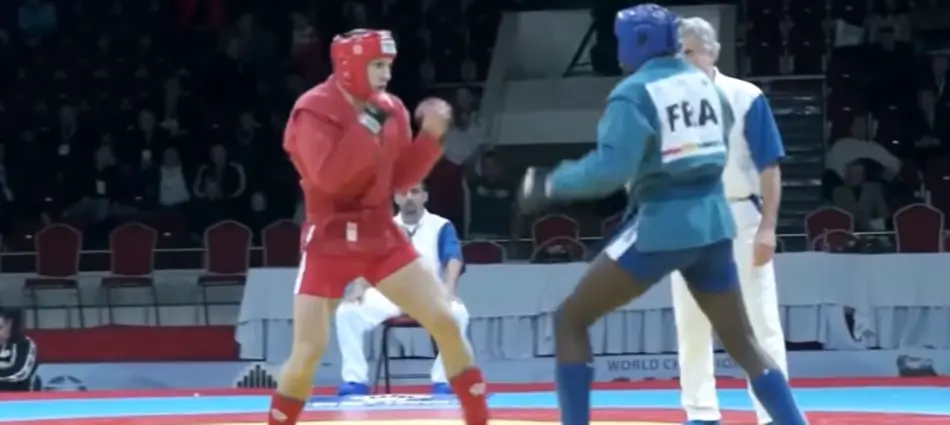
Before writing this article I checked this document (International Sambo competition Rules) to make sure I understand the rules completely. You can check it out if you want more information.

